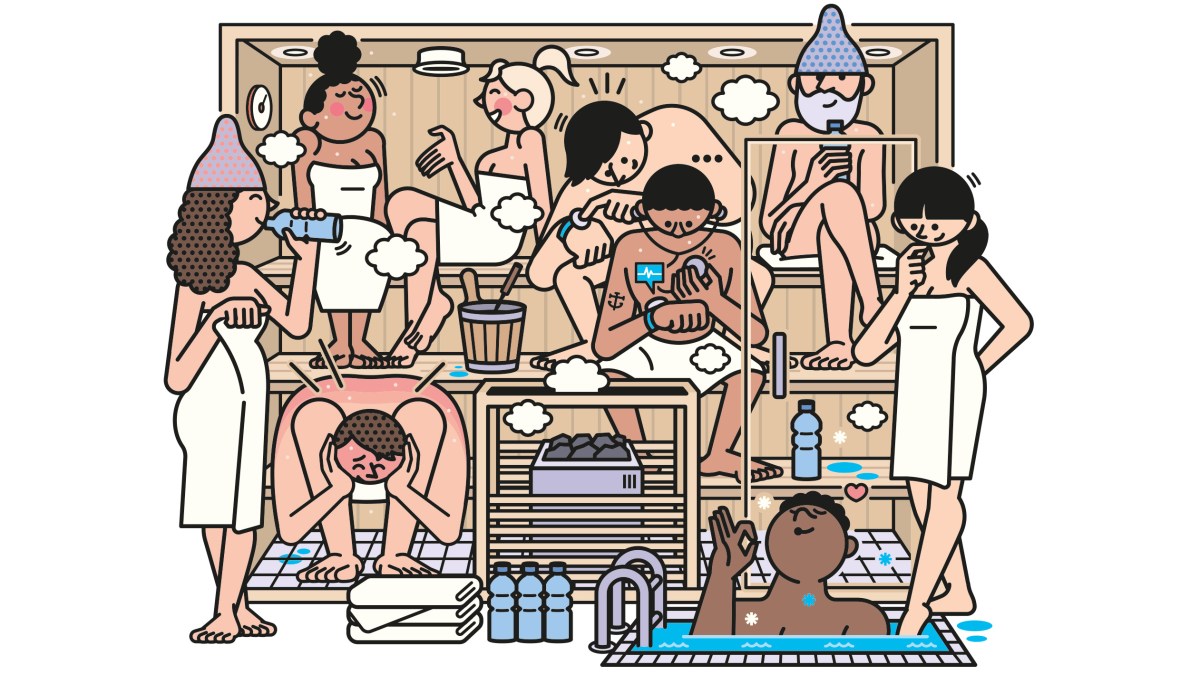For thousands of years our Nordic cousins have enjoyed getting hot and sweaty in a sauna. As well as providing many health benefits, saunas have been places to socialise — and even give birth, as was common in Finland until the 1940s. Now Brits are finally catching up: the British Sauna Society counted more than 400 public saunas across the UK this year, up from 45 in 2023. If you’re a newbie, here’s what you need to know.
What are the health benefits?
Sweating in a sauna is proof that your body is working to cool you down. Your blood vessels have dilated, improving blood flow, and your heart rate rises to 100-150bpm — equivalent to moderate to high-intensity exercise such as a steady cycle. “Over time with regular sauna use, this increased circulation could lower blood pressure, improving your cardiovascular health,” says Dr Suzanne Wylie, a GP and medical adviser for IQ Doctor, an online pharmacy. “Saunas can also reduce stress and improve sleep quality.” This is because the heat triggers the release of stress-busting beta-endorphins; and after a sauna your core body temperature drops, which signals to your brain to release the sleep hormone melatonin.
• Should we all be taking regular saunas?
What makes a good sauna?
The best saunas won’t feel like sweltering torture chambers, but “many in the UK will have been built in poorly ventilated cabins”, says Gabrielle Reason, director of the British Sauna Society. Wood-fired saunas should draw in fresh air through a low vent and have a chimney. You might prefer an electric sauna if you don’t fancy tending to a fire, but you’ll miss out on the ritualistic feel. In Finland, the word löyly is used to mean the steam that rises when you pour water over hot stones in a sauna. This increases the humidity and circulation of the air to make the heat feel more breathable. Löyly is such an important part of the culture that it’s considered an honour to be the person in charge of it. It might not have the same prestige in the UK, so you are best off asking those around you before ladling on more water.
Do I have to go in naked?
In Japan and Nordic countries nudity is a normal part of sauna culture. Many Swedes and Finns prefer to go au naturel, as their saunas, like those in Germany and Austria, often ban swimwear for hygiene reasons. If the thought of baring all makes you even sweatier, don’t worry: in the UK it’s typical to wear trunks or a towel. Shower first, bring a towel to sit on too, and check the rules of your sauna.
• ‘A Viking sauna with my mum? We had never felt better’
How long should I stay in?
Start with five to ten minutes and gradually increase to fifteen to twenty minutes, two to four times a week. “Listen to your heartbeat — it should rise to the level it does during a gentle jog,” Reason says. “Once it reaches that medium rhythm, step out and rest.”
Hydrate, too. “Consume 500ml of water 30 minutes beforehand,” says Francesca Bagshaw, a performance physiologist at Nuffield Health. Weigh yourself before and after and drink about 1.5 times the amount of water you lost. Some people wear bell-shaped hats made from wool or felt. “They keep your head cooler by insulating it,” Reason says.
Do I have to take a cold plunge?
Brace yourself: in Nordic countries it is popular and many UK saunas have plunge pools. “Switching between a cold pool of 10C to 13C for 90 seconds and the sauna at 60C to 90C for at least three minutes opens and narrows the blood vessels to create a pumping action within the muscle,” Bagshaw says. “This increased blood flow helps with muscle soreness.” A cold plunge can also activate brown fat, which generates heat by burning through glucose and fatty acids. Over time, this can slightly boost your metabolism. A short dip is fine; push it too far and you risk triggering heart arrhythmias and losing consciousness.
• The good sauna guide: the UK’s 20 hottest ones to book now
How hot is too hot?
Do take care. High temperatures can tip our bodies into heat “stress”, making us feel faint and nauseous. If you experience this, blurred vision, headache, palpitations, cramps or feel confused, “Exit, sit or lie down somewhere cool, sip water and rest,” Reason says. If you have a medical condition such as epilepsy, cardiovascular issues, a severe respiratory condition, a skin disorder such as eczema or are pregnant, consult your GP before using a sauna. Also, be aware that some medications, such as sertraline and beta blockers, impair temperature regulation. Tolerable discomfort, however, may not be heat stress. Our bodies release the opioid peptide dynorphin as a response to the “stress” of being in a sauna. Dynorphin increases the sensitivity of the brain’s receptors to beta-endorphins, which reduce stress and work as natural painkillers. Never push yourself too hard — and listen to your heartbeat. Bagshaw recommends deep, steady breathing to calm the nervous system. “Start on a lower bench if it’s cooler, remove heavy towels and sip water.”
The British Sauna Society has a directory of UK saunas; britishsaunasociety.org.uk

